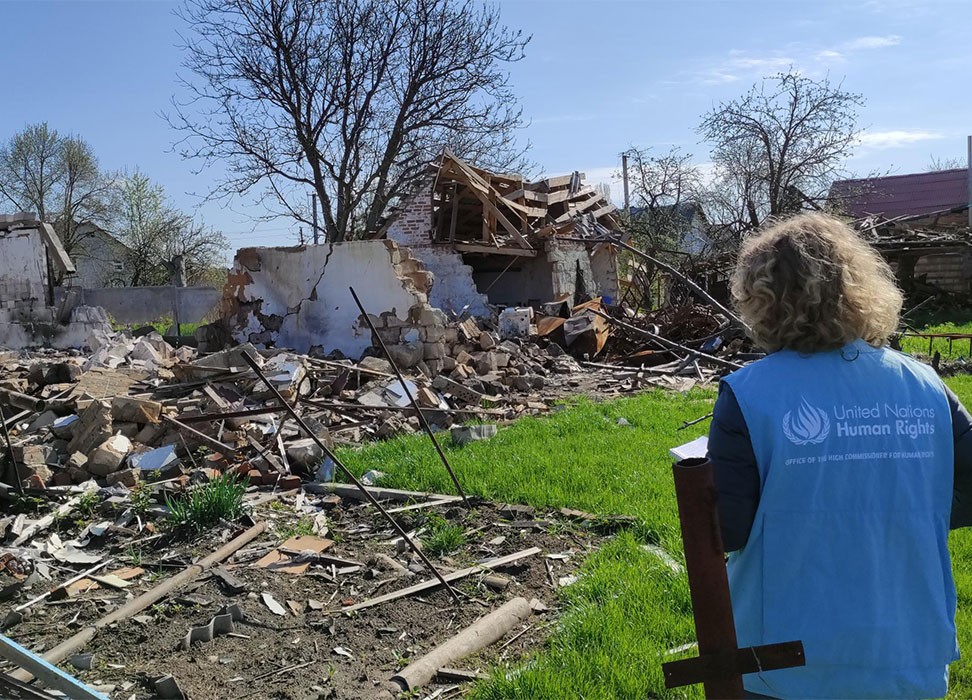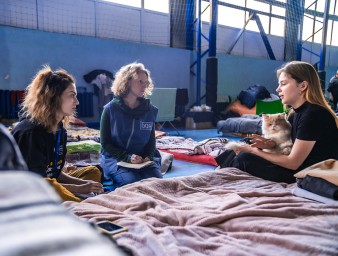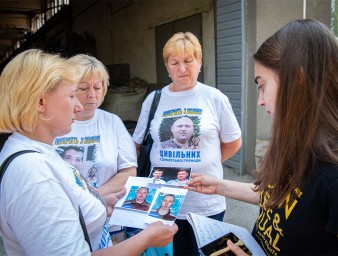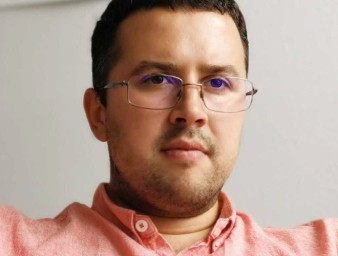Ukraine: Monitoring the devastating impact of the war on civilians
24 May 2022

Since the start of the war in Ukraine, UN Human Rights Monitoring Mission in Ukraine (HRMMU) has documented serious violations of international humanitarian and human rights law. Matilda Bogner, who heads the Mission, understands the challenges of documenting abuses during conflicts. She is a lawyer with 16 years of experience with UN Human Rights, much of it monitoring violations in conflict and post-conflict situations. Back from a recent monitoring visit of 14 towns in Kyiv and Chernihiv regions that were occupied by Russian armed forces, Bogner answers questions about the kinds of abuses observed and if these actions constitute war crimes.
How does the war in Ukraine compare to other countries where you have had a monitoring mandate?
I would say the intensity of this conflict has been much higher than the intensity of many other conflicts. One thing that is the same in many armed conflicts is the suffering of civilians.
HRMMU collects information that can, for instance, be used as evidence of gross violations of human rights like war crimes. How do you collect information that could lead to proof of international crimes?
We interview victims. We interview witnesses. We try to visit sites to actually see the places where crimes may have occurred. But we also use a range of other sources. We use publicly available information, such as video evidence and photographs. We also get information from trusted partners as well as information that’s provided by governments.
What are some of the trends in the violations you have observed in this conflict?
In the beginning, what we were seeing was the use of explosive weapons in populated areas that led to a high level of civilian casualties, as well as destruction and damage to civilian objects. After that, we’ve documented unlawful killings, including summary executions. We’ve documented sexual violence in the context of the conflict. We have also documented enforced disappearances, torture, and ill treatment. As an example, we have found that the majority of victims of enforced disappearances reportedly committed by the Russian armed forces and affiliated armed groups were active or former public officials of local authorities or their relatives, human rights defenders and civil society activists, journalists, religious workers, and retired servicemen of the Ukrainian armed forces. We also documented cases of enforced disappearances, reportedly perpetrated by the law enforcement agencies of Ukraine. Victims in these cases are usually suspected of having provided assistance to the Russian Federation.
Are there some violations that are difficult to prove?
Certainly, if we look at conflict-related sexual violence, that is one of the very difficult areas because victims and witnesses often don't want to speak about it publicly. There's a huge stigma against victims of sexual violence. And this runs across societies. So, we need to respect the victims. We need to respect the witnesses’ wishes. If they don't wish to talk, maybe they will want to talk in one year or several years later. But the important thing is to have a victim-centred approach where we respect their wishes and don't further stigmatize them.
You are recently back from a visit to 14 towns in the Kyiv and Chernihiv regions that were occupied by Russian armed forces and met with people who lived under the occupation. What kinds of things did they speak to you about?
Last week I was in a town to the north of Kyiv. I met with many victims and witnesses. Unfortunately, it was very easy to find victims and witnesses... We met a man who had been in his house. His wife and children had evacuated. He was sharing the cooking with his neighbors because there was no electricity. They were building fires and doing their cooking together. One day, Russian forces came, asked them to come out onto the street and looked through their telephones. They didn't like what they saw in the telephone of one of them, so they took him away and shot him. The man we spoke to had heard the shots. He then later buried the body of his neighbor.
Do the personal stories lead you to decide the direction of the team as far as the investigation?
When we start to see that a pattern of violations is emerging, we really try to focus on that to understand its scale and the way that it’s impacting on the victims. Of course, every violation is important to document, but it is also important to understand what types of patterns are emerging because that will help us in terms of trying the advocate for prevention into the future, as well as understanding where accountability mechanisms should focus in the future.
What is involved in qualifying an events, activity or action as a war crime? What methodology do you use?
A final qualification of whether a war crime has been committed should be carried out by a court with a relevant mandate. From our side, we make our conclusions based on the “reasonable grounds to believe” standard of proof. Based on verified information, an ordinarily prudent observer would have reasonable grounds to believe that the facts took place as described and that these facts meet all the elements of a violation. You have to look specifically at the individual incident. We look at whether there was a military object close by, whether it was therefore a legitimate military target, were the weapons used in an appropriate fashion to only target that? Was it considered there were civilians around who could have been harmed or not? We need to look at all those types of issues as well as what was the actual damage that occurred.
How would you qualify what you’ve seen so far?
Most of the destruction, the overwhelming majority of destruction of civilian objects, as well as the killing and injuring of civilians has been caused by the widespread use of explosive weapons in populated areas. Not every single case will be a violation of international humanitarian law and will not be a war crime. But the extent of the damage, the extent of the deaths of civilians leads us to believe there have been war crimes committed, including the indiscriminate use of weapons.
The HRMMU has been in the country since 2014, and mandated to monitor, report and advocate on the human rights situation in Ukraine. Since the start of the war, how has the work changed?
Since the 24th of February, our work has changed significantly. We have had to reorient to focus exclusively on conflict-related issues. We’ve had to move our staff from areas that have been very unsafe to other parts of the country. The scale of violations has increased enormously. So, it has really stretched our capacity to the limit.
What challenges do you face while doing your work?
We have limited access to different parts of the country, particularly those areas that are under intense hostilities. This has meant we have to do remote monitoring. We have to rely on the networks that we’ve built over the years that we’ve been in Ukraine. But, when communications go down, we really don’t have access to information in those types of areas.
Do you have any collaboration with the Ukrainian authorities?
We certainly are in constant dialogue with the Ukrainian authorities. I met last week with the General Prosecutor’s Office, with other law enforcement bodies. We discussed the information that we have. We raised concerns with them. We hear about the type of information that they have in order to help us in terms of what we should look at next.



